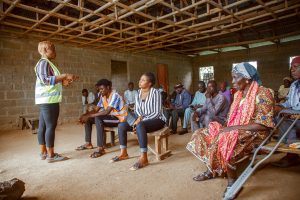
Broken Links
How can open data help shine a light on political corruption and make political systems fairer and more inclusive? How can we further link people and data to create a chain of accountability? Explore our new report.

The fight for gender equality often centers around the importance of being seen, of shining a light on the often-hidden challenges that can be exacerbated by a person’s sex, gender, gender identity, or sexual orientation. Examples of these challenges are barriers in accessing loans or public procurement tenders for women-owned businesses, the ability of girls or boys to consistently attend school, and LGBTQIA+ discrimination in health care or employment. Collecting and publishing disaggregated gender data that captures these disparities is critical to addressing inequality and injustice across and within different communities. According to Equal Measures 2030, without open gender data, “it is impossible to identify where needs are greatest or measure the impact of policies and programs.” However, considerable gaps in gender data collection, publication, and use persist in many countries due to data inaccessibility, interoperability, or the use of non-open formats.
Note: Gender data may disaggregate information by men, women, or other gender and sexual identity characteristics and experiences. In this chapter, references to “women” include those who identify as women, whether cisgender, transgender, or intersex women. Sex-disaggregated data often refers to binary “sex assigned at birth” characteristics of male and female, while gender data may take into account additional lived experiences and identities. Depending on the circumstances, there may be times in which it is beneficial to collect both sex and gender-disaggregated data.
With OGP’s 2023-2028 Strategy, OGP members are set to work toward a number of aspirational thematic reforms through the Open Gov Challenge. This section of the Open Gov Guide addresses Gender and Inclusion.
Challenge prompt: Adopt open government reforms to promote the full participation of women and under-represented groups politically, socially and economically.
Actions and reforms that fit within the scope of this challenge area are:
Definitions for key terms such as gender mainstreaming and open gender data.
Open gender data can support better decision-making and fairer access to services.
The recommendations below represent reforms that national and local governments, representatives of civil society organizations, and others can consider for their action plans and the Open Gov Challenge. The reforms are categorized according to OGP’s principal values: transparency, civic participation, and public accountability. Reforms should be adapted to fit the domestic context, and involve and coordinate with other levels and branches of government.
Reforms across policy areas are also tagged by the estimated degree of difficulty in implementation. Though progress is often not linear, the recommendations have been categorized using these labels to give the reader a sense of how different reforms can work together to raise the ambition of open government approaches.
Transparency: Transparency empowers citizens to exercise their rights, hold the government accountable, and participate in decision-making processes. Examples of relevant activities include the proactive or reactive publication of government-held information, legal or institutional frameworks to strengthen the right to access information, and disclosing information using open data standards.
Civic Participation: When people are engaged, governments and public institutions are more responsive, innovative, and effective. Examples of relevant initiatives include new or improved processes and mechanisms for the public to contribute to decisions, participatory mechanisms to involve underrepresented groups in policy making, and a legal environment that guarantees civil and political rights.
Public Accountability: Public accountability occurs when public institutions must justify their actions, act upon requirements and criticisms, and take responsibility for failure to perform according to laws or commitments. Importantly, public accountability means that members of the public can also access and trigger accountability mechanisms. Examples of relevant activities include citizen audits of performance, new or improved mechanisms or institutions that respond to citizen-initiated appeals processes, and improved access to justice.
Inclusion: Inclusion is fundamental to achieving more equitable, representative, and accountable policies that truly serve all people. This includes increasing the voice, agency, and influence of historically discriminated or underrepresented groups. Depending on the context, traditionally underrepresented groups may experience discrimination based on gender, sexual identity, race, ethnicity, age, geography, differing ability, legal, or socioeconomic status.
Foundational: This tag is used for reforms that are the essential building blocks of a policy area. “Foundational” does not mean low ambition or low impact. These recommendations often establish basic legal frameworks and institutional structures.
Intermediate: This tag is used for reforms that are complex and often involve coordination and outreach between branches, institutions, and levels of government, with the public or between countries.
Advanced: This tag is used for reforms that close important loopholes to make existing work more effective and impactful. Specifically, “Advanced” reforms are particularly ambitious, innovative or close important loopholes to make existing work more effective, impactful or sustainable. They are often applied in mature environments where they seek to institutionalize a good practice that has already shown results.
Executive: The executive branch of government is responsible for designing, implementing, and enforcing laws, policies, and initiatives. It is typically led by the head of state or government, such as a president or prime minister, along with their appointed cabinet members. The executive branch’s functions also include overseeing the day-to-day operations of the government, managing foreign affairs, and directing the country’s armed forces. In democratic systems, the executive branch is accountable to the legislature and the electorate, with its powers and limitations outlined in the constitution or legal framework of the respective country.
Legislative: The legislative branch of government is responsible for making laws and regulations and overseeing the functioning of the government. It typically consists of a body of elected representatives, such as a parliament, congress, or assembly, which is tasked with proposing, debating, amending, and ultimately passing legislation. The legislative branch plays a crucial role in representing the interests of the people, as its members are elected to office by the public. In addition to law-making, this branch often holds the power to levy taxes, allocate funds, and conduct certain investigations into matters of public concern. The structure and powers of the legislative branch are usually outlined in a country’s constitution or legal framework, and it serves as a check on the executive and judicial branches to ensure a system of checks and balances within a state.
Implementing bodies charged with improving the quantity and quality of gender data can begin by prioritizing the collection and publication of high-value data. As mentioned above, gender data should include a broad definition of “women” that encompasses cisgender, transgender, and intersex women.
Below is a checklist of some of the most important types of high-priority gender data, with a full list available in the Indicators Annex of the 2023 Gender Data Compass report.
The following examples are commitments previously made within or beyond OGP that demonstrate elements of the recommendations made above. OGP members began making open gender data commitments in 2017 and have increasingly co-created commitments in this policy area since then. About 30 percent of OGP national members have at least one open gender data-related commitment.
Discussions of open data in general, and open gender data in particular, tend to focus on the need for national-level gender ministries and statistical offices to improve their practices and take on more responsibility as central coordinators to improve data collection, publication, and use.
However, local governments have an important role to play in ensuring that national-level data practices fully capture trends taking place in smaller frames of measurement—within and between households, at the municipal level, and at the state or provincial level. This is why disaggregation by location and at the intra-household level is just as critical as disaggregation by sex and gender, as described in the “Recommended Reforms” section above. Challenges faced by specific groups—such as those living in temporary housing within cities—are often overlooked in traditional data collection practices. Local governments can therefore help address these gender data gaps.
This list reflects members with commitments in the “Gender” policy area of the Data Dashboard.
The following organizations have recently worked on this issue in the context of OGP at the national or international level. They may have additional insights on the topic. Please note that this list is not exhaustive. If you are interested in national-level initiatives, please contact [email protected].
The OGP 2023-2028 Strategy sets out the Open Gov Challenge and aims to provide clear benchmarks for performance through reliable data.
While benchmarks for individual countries and Open Gov Guide recommendations are not yet integrated, for this chapter, interested individuals may rely on the following data sets:
While the list below is not exhaustive, it aims to provide a range of recommendations, standards, and analysis to guide reform in this policy area.

How can open data help shine a light on political corruption and make political systems fairer and more inclusive? How can we further link people and data to create a chain of accountability? Explore our new report.

The promise of democracy is often defined by the ballot box, where citizens determine who will represent their interests in government. That promise, however, too often fails to translate to the reality of people’s daily lives...

Evidence continues to show that open government affects people’s lives. But there are still skeptics who are not aware of all the benefits associated with this approach. Use this guide to convince them to take an open government approach when implementing reforms.

The OGP Justice Policy Series is a three-part series on Access to Justice, Open Justice, and Accountability for Democratic Renewal. It aims to highlight the important synergies between justice and open government and the ways in which countries can use OGP to make accountable, credible improvements to their justice systems.
Access data on OGP commitments. Filter commitments by location, policy area, and year. Search by keyword.

This guide is a one-stop shop for the best current resources on how open government projects and approaches can support tackling the pandemic.
Nos encontramos en un momento de gran incertidumbre para los gobiernos, la sociedad civil y la ciudadanía. En el contexto del reto sin precedentes que representa la pandemia de coronavirus, los gobiernos están probando políticas y metodologías en tiempo real...
En ce moment, l'incertitude est à son maximum pour les gouvernements, la société civile et les citoyens. Face au défi unique que représente le Coronavirus, de nouvelles politiques et approches sont testées en temps réel...
Click here for more information about the Open Government Partnership's terms of use.
Terms & Conditions Close